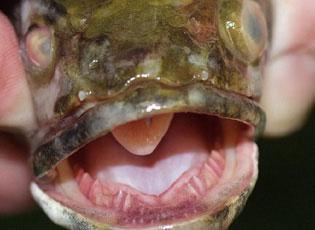Channa argus (ITIS)
Northern Snakehead, Chesapeake Channa (Maryland Senate Bill 207 snakehead name change)
Eastern Asia (NAS Database)
First established population discovered in Crofton, Maryland in 2002 (NAS Database)
Released from fish markets (NAS Database)
Preys on and competes with native species (NAS Database)

Northern snakehead, open mouth showing sharp teeth, Photo by U.S. Geological Survey
Find more images
Spotlights
Distribution / Maps / Survey Status
Federally Regulated
All Resources
Selected Resources
The section below contains highly relevant resources for this species, organized by source.
Council or Task Force
Partnership
Federal Government
State and Local Government
Academic
Professional
Integrated Taxonomic Information System. Channa argus. [Accessed Sep 21, 2023].
Nonindigenous Aquatic Species Database. Fact Sheet - Northern Snakehead. USGS, Gainesville, FL. [Accessed Sep 21, 2023].
